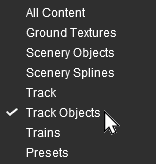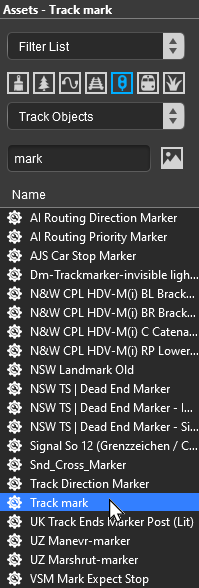How to Use S20 Tools
m (→The Placement Tool) |
m (→The Placement Tool) |
||
| Line 551: | Line 551: | ||
The '''Placement Tool''' is used to add assets to the landscape. | The '''Placement Tool''' is used to add assets to the landscape. | ||
| + | The first step is to identify and select tha particular asset that you want to place.<br> | ||
| + | |||
| + | [[image:DotPoint1.JPG|link=]] In the '''Asset Palette''' either:- | ||
| + | <table width=1000> | ||
| + | <tr valign="top"> | ||
| + | <td> | ||
| + | <table border=1> | ||
| + | <tr valign="top"> | ||
| + | <td width=250 align="center">[[image:Ablue.png|link=]] '''Left''' click on an asset selection icon<br> | ||
| + | [[image:FilterSelectIcons.png|link=|alt=Filter Icons]] | ||
| + | <table> | ||
| + | <tr valign="top" align="left"> | ||
| + | <td>[[image:GroundTextureFilter_S20.png|link=]]</td> | ||
| + | <td>all ground textures</td> | ||
| + | </tr> | ||
| + | <tr valign="top" align="left"> | ||
| + | <td>[[image:SceneryMeshFilter_S20.png|link=]]</td> | ||
| + | <td>all non-spline scenery objects</td> | ||
| + | </tr> | ||
| + | <tr valign="top" align="left"> | ||
| + | <td>[[image:ScenerySplineFilter_S20.png|link=]]</td> | ||
| + | <td>all spline scenery objects</td> | ||
| + | </tr> | ||
| + | <tr valign="top" align="left"> | ||
| + | <td>[[image:TrackSplineFilter_S20.png|link=]]</td> | ||
| + | <td>all track spline objects</td> | ||
| + | </tr> | ||
| + | <tr valign="top" align="left"> | ||
| + | <td>[[image:TrackMeshFilter_S20.png|link=]]</td> | ||
| + | <td>all track objects (signals, etc)</td> | ||
| + | </tr> | ||
| + | <tr valign="top" align="left"> | ||
| + | <td>[[image:TrainFilter_S20.png|link=]]</td> | ||
| + | <td>all rolling stock</td> | ||
| + | </tr> | ||
| + | <tr valign="top" align="left"> | ||
| + | <td>[[image:PresetFilter_S20.png|link=]]</td> | ||
| + | <td>all '''Effect Layer''' presets</td> | ||
| + | </tr> | ||
| + | </table> | ||
| + | </td> | ||
| + | </tr> | ||
| + | </table> | ||
| + | </td> | ||
| + | <td width=50 align="center"><span style="font-size: 17px; font-weight: 700;">OR</span></td> | ||
| + | <td> | ||
| + | <table border=1> | ||
| + | <tr valign="top"> | ||
| + | <td align="center">[[image:Bblue.png|link=]] '''Left''' click the '''Content Drop-down Box'''<br> | ||
| + | [[image:FilterSelect.png|link=|alt=Filter List]]<br> | ||
| + | Then select '''Track Objects'''<br> | ||
| + | [[image:FilterSelectTrackType.png|link=|alt=Track Objects]] | ||
| + | </td> | ||
| + | </tr> | ||
| + | </table> | ||
| + | </td> | ||
| + | <td> | ||
| + | <table bgcolor=#000000 width=400 cellpadding=2> | ||
| + | <tr valign="top"> | ||
| + | <td> | ||
| + | <table bgcolor=#ffffb0 width=396 cellpadding=2> | ||
| + | <tr valign="top"> | ||
| + | <td width=22>[[image:NotePad.PNG|link=]]</td> | ||
| + | <td width=374><span style="font-size: 17px; font-weight: 700;">Notes:'''</span><br> | ||
| + | ---- | ||
| + | </td> | ||
| + | </tr> | ||
| + | <tr valign="top"> | ||
| + | <td colspan=2> | ||
| + | If the '''Assets Palette''' is not shown on the screen, then:- | ||
| + | <table> | ||
| + | <tr valign="top"> | ||
| + | <td width=175>[[image:WindowsMenu_S20.png|link=|alt=Windows Menu]]</td> | ||
| + | <td> | ||
| + | <table> | ||
| + | <tr valign="top"> | ||
| + | <td>1. </td> | ||
| + | <td>open the '''Window Menu''' from the menu icons at the top of the screen</td> | ||
| + | </tr> | ||
| + | <tr valign="top"> | ||
| + | <td>2. </td> | ||
| + | <td>'''Left''' click on the '''Assets Palette''' name</td> | ||
| + | </tr> | ||
| + | <tr valign="top"> | ||
| + | <td colspan=2>to add a tick and make it visible.</td> | ||
| + | </tr> | ||
| + | </table> | ||
| + | </td> | ||
| + | </tr> | ||
| + | </table> | ||
| + | </td> | ||
| + | </tr> | ||
| + | </table> | ||
| + | </td> | ||
| + | </tr> | ||
| + | </table> | ||
| + | </td> | ||
| + | </tr> | ||
| + | </table> | ||
| + | |||
| + | <table bgcolor=#000000 width=600 cellpadding=2> | ||
| + | <tr valign="top"> | ||
| + | <td> | ||
| + | <table bgcolor=#ffffe0 width=596 cellpadding=2> | ||
| + | <tr valign="top"> | ||
| + | <td>[[image:PencilTips.PNG|link=]] <span style="font-size: 15px; font-weight: 700; color: white; background-color: blue;"> Shortcut </span><br> | ||
| + | If you already have the same asset placed in your route then:- | ||
| + | # select the '''Eyedropper Tool''' in the '''Tools Palette''' (or press the <span style="font-weight: 700; font-size: 17px; color: white; background-color: black;"> R </span> key) | ||
| + | # '''Left''' click on the existing asset object | ||
| + | This will instantly select that particular asset in the filter list.<br> | ||
| + | |||
| + | Jump to '''Step [[image:DotPoint5.JPG|link=]]''' below.</td> | ||
| + | </tr> | ||
| + | </table> | ||
| + | </td> | ||
| + | </tr> | ||
| + | </table> | ||
| + | <br> | ||
| + | [[image:DotPoint2.JPG|link=]] To narrow down the filter list type part of the asset name into the '''Search Text Box'''. For example if you have selected '''Track Objects''' and want to find "Trackmarks", then type "mark" ('''UPPER/lower''' case does not matter).<br> | ||
| + | <table width=1000> | ||
| + | <tr valign="top"> | ||
| + | <td>[[image:FilterSelectSearch.png|link=|alt=Text search]]</td> | ||
| + | <td><br>[[image:DotPoint3.JPG|link=]] This will list all the '''Track Objects''' containing the text "mark" in the filter list.<br> | ||
| + | <table> | ||
| + | <tr valign="top"> | ||
| + | <td>[[image:FilterSelectTrackMark.png|link=|alt=Filtered list]]</td> | ||
| + | <td valign="middle">[[image:DotPoint4.JPG|link=]] Select the item '''Track Mark'''.<br><br> | ||
| + | If you are not sure about an asset then '''double-click''' on the name to bring up its image and description.</td> | ||
| + | </tr> | ||
| + | </table> | ||
| + | </td> | ||
| + | </tr> | ||
| + | </table> | ||
| + | <table width=1000> | ||
| + | <tr valign="top"> | ||
| + | <td width=400>[[image:DotPoint5.JPG|link=]] Place the selected object into the landscape.<br> | ||
| + | # '''Click''' the '''Placement Tool''' or press the <span style="color: white; background-color: black; font-weight: 700; font-size: 15px;"> E </span> key | ||
| + | # '''Click''' on the spot where you want to place the object</td> | ||
| + | <td width=600> | ||
| + | <table bgcolor=#000000 width=600 cellpadding=2> | ||
| + | <tr valign="top"> | ||
| + | <td> | ||
| + | <table bgcolor=#ffffb0 width=596 cellpadding=2> | ||
| + | <tr valign="top"> | ||
| + | <td>[[image:NotePad.PNG|link=]]</td> | ||
| + | <td>The '''Placement Tool''' will remain on and active until another tool has been selected. So everytime you click another copy of the asset (or another asset if you change your selection) will be added to the landscape.</td> | ||
| + | </tr> | ||
| + | </table> | ||
| + | </td> | ||
| + | </tr> | ||
| + | </table> | ||
| + | </td> | ||
| + | </tr> | ||
| + | </table> | ||
| + | <br> | ||
<table bgcolor=#000000 width=480 cellpadding=2> | <table bgcolor=#000000 width=480 cellpadding=2> | ||
<tr valign="top"> | <tr valign="top"> | ||
Revision as of 13:39, 7 January 2023
The information in this Wiki Page applies to Surveyor 2.0 (S20) as found in Trainz Plus.
This document is under development
|
|
|||||||||
The Tools Palette
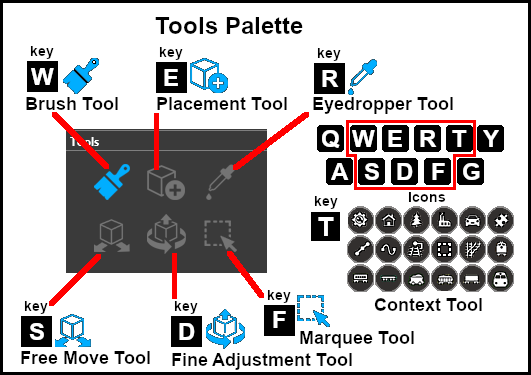 |
|
|||||||||||||||||
The Brush Tool
The Brush Tool is used for painting the landscape. It can:-
When selected, the Brush Tool will show two drop down menu lists. |
 |
The first drop down menu will set the Brush Target, the type of brush. The Targets are:-
|
 |
Ground Height
When this Target is selected, the second drop down box will give a choice of several Ground Height tools. The choices are:-
|
 |
| The different control options available with this brush tool are shown in the Tools Options Palette. If this palette is not visible on the screen then refer to Notes: Palettes at the top of this document. The available brush tool options are shown with a Gold coloured icon next to their names. Those options that have their icon greyed out will be ignored, but they can still be edited. |
|||||||||||||||||||||||||||||||||||
Height Up/Height Down  |
Set Height  |
Grade 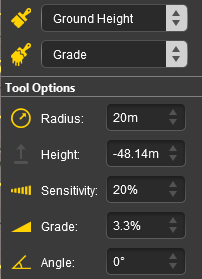 |
|
||||||||||||||||||||||||||||||||
|
Ground Texture
When this Target is selected, the second drop down box will be disabled - there are no brush texture tool choices. The different control options available with this brush tool are shown in the Tools Options Palette. If this palette is not visible on the screen then refer to Notes: Palettes at the top of this document.
The available brush tool options are shown with a Gold coloured icon next to their names. Those options that have their icon greyed out will be ignored, but they can still be edited.
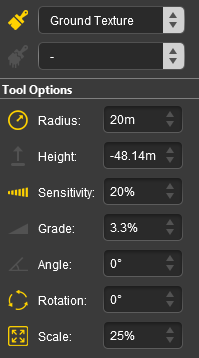 |
|
||||||||||||||||||||||||||
|
Scrapbook Data
When this Target is selected, the second drop down box will give a choice of two Scrapbook Data tools. The choices are:-
|
| The different control options available with this brush tool are shown in the Tools Options Palette. This brush tool also uses the Scrapbook Palette. If both of these palettes are not visible on the screen then refer to Notes: Palettes at the top of this document. The available brush tool options are shown with a Gold coloured icon next to their names. Those options that have their icon greyed out will be ignored, but they can still be edited. |
||||||||||||||||||||||||||
Scrapbook Clone  |
Scrapbook Brush  |
|
||||||||||||||||||||||||
|
The Srapbook Palette 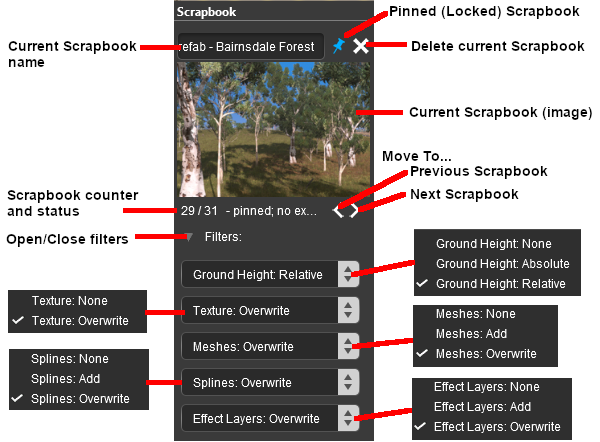 |
|
|||||||||||||||||||||||||||||||||||||||
Edit Effect Layers...
The Placement Tool
| Keyboard Shortcut: E |
The Placement Tool is used to add assets to the landscape.
The first step is to identify and select tha particular asset that you want to place.
In the Asset Palette either:-
|
OR |
|
|
|||||||||||||||||||||||||||||
|
To narrow down the filter list type part of the asset name into the Search Text Box. For example if you have selected Track Objects and want to find "Trackmarks", then type "mark" (UPPER/lower case does not matter).
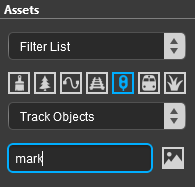 |
|
|
|
|
The Eyedropper Tool
| Keyboard Shortcut: R |
The Eyedropper Tool is used to identify objects that are in the landscape. The objects can be textures, effect layers, scenery, rolling stock, track and track equipment, and splines.
The Free Move Tool
| Keyboard Shortcut: S |
The Free Move Tool is used to move objects in the landscape.
The Fine Adjustment Tool
| Keyboard Shortcut: D |
The Fine Adjustment Tool is used to make fine adjustments (XYZ axis, rotation, tilt) to objects in the landscape.
The Marquee Tool
| Keyboard Shortcut: F |
The Marquee Tool is used to select areas of the landscape.
Trainz Wiki
 |
More Tutorials and Guides to Using Trainz |
This page was created by Trainz user pware in January 2023 and was last updated as shown below.



